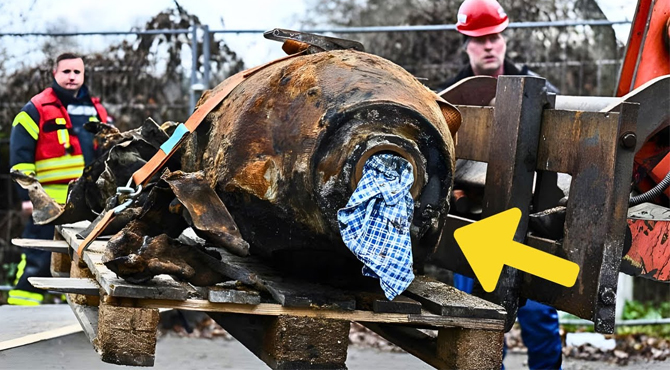In the midst of routine construction work in Augsburg, Germany, a team of workers stumbled upon a chilling relic from the past – an unexploded two-ton bomb dating back to World War II. The unexpected discovery prompted an immediate evacuation of the city, marking the largest mass exodus since the war itself.
In 2016, as construction crews were diligently working to lay down foundations in one of Germany’s oldest cities, they uncovered the ominous wartime artifact buried beneath the earth. The construction workers, initially skeptical of their find, quickly realized the gravity of the situation and promptly ran for their lives. Authorities were notified, and the construction site manager halted all work until specialists could assess the danger.
The unexploded bomb, believed to belong to the British Royal Air Force, served as a stark reminder of the intense bombing campaigns during World War II. Germany, even after more than 70 years since the war’s end, continues to grapple with the legacy of unexploded ordnance buried beneath its cities.
During World War II, Germany endured relentless bombings, with over 2.7 million tons of bombs dropped by British and United States air forces, causing significant devastation. An estimated 10 percent of these bombs failed to detonate and remain hidden underground, posing a persistent threat to unsuspecting residents.
With the holiday season in full swing, authorities faced a dilemma – whether to evacuate the city immediately, disrupting Christmas for thousands, or delay the bomb’s disposal until after the holidays. After comprehensive research revealed the bomb’s potential size and destructive power, officials opted for an urgent evacuation.
On Christmas day, 54,000 residents were forced to leave their homes, marking the largest evacuation since the war. The process involved over 100 buses and trams to swiftly relocate citizens out of harm’s way. Police officers, equipped with air horns and megaphones, patrolled the empty streets to ensure everyone adhered to the evacuation order.
Two bomb disposal experts from Wurzburg faced the daunting task of defusing the two-ton bomb. Strict protocols limited the operation to only two individuals within a mile of the bomb, emphasizing the risks involved. The experts, aware of the potential consequences, worked tirelessly for hours to ensure a safe disposal.
The incident in Augsburg sheds light on Germany’s ongoing struggle with unexploded ordnance. The country’s Bomb Disposal Units, known as kmbd, work diligently to locate and remove these hidden threats. Despite over 30 years of dedicated efforts, nearly 500 tons of weaponry are discovered annually, underscoring the persistent danger faced by German communities.
While every effort is made to minimize the threat, Germany acknowledges that it will take years to ensure the complete removal of unexploded bombs. The kmbd continues its exhaustive work, discovering and diffusing wartime remnants to safeguard the lives of citizens and allow them to live without the constant specter of the past.
The unearthing of an unexploded bomb in Augsburg serves as a chilling reminder of the enduring impact of World War II. Germany’s commitment to addressing this ongoing threat reflects the delicate balance between preserving history and securing the safety of its citizens. The dedication of individuals like Horse Reinhardt, chief of the Brandenburg state kmbd, highlights the ongoing efforts to build a safer future in the aftermath of a tumultuous past.










